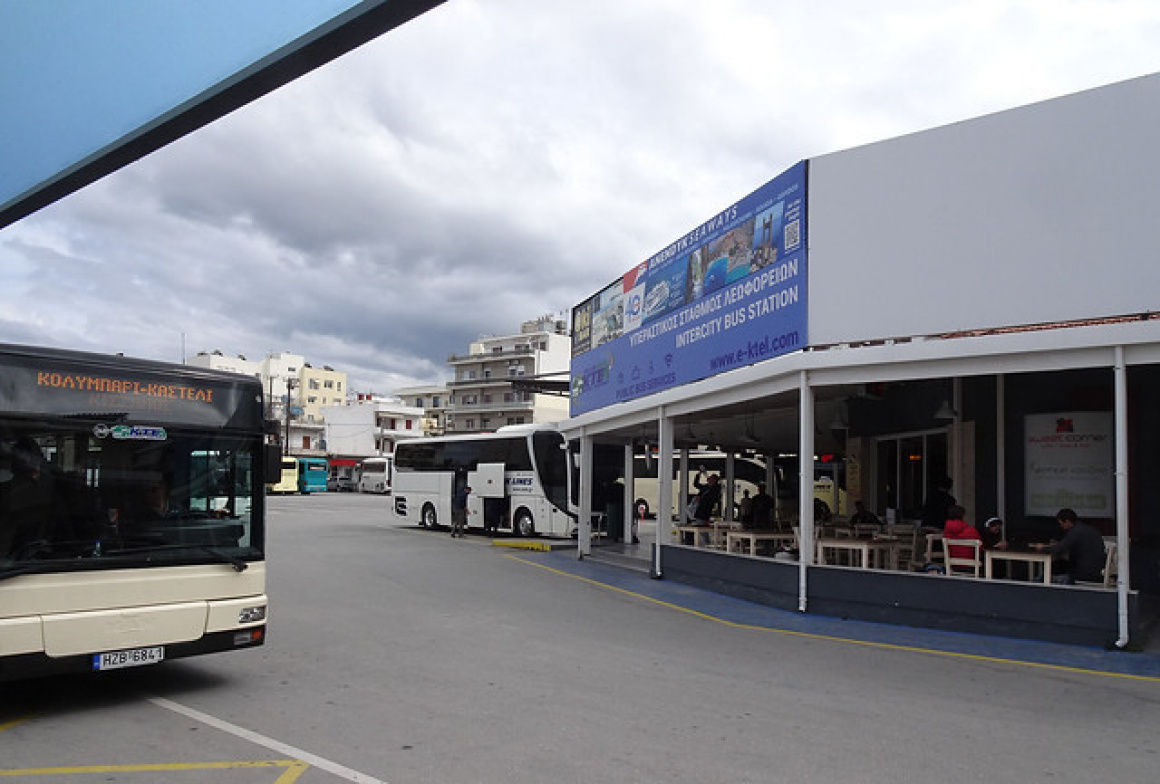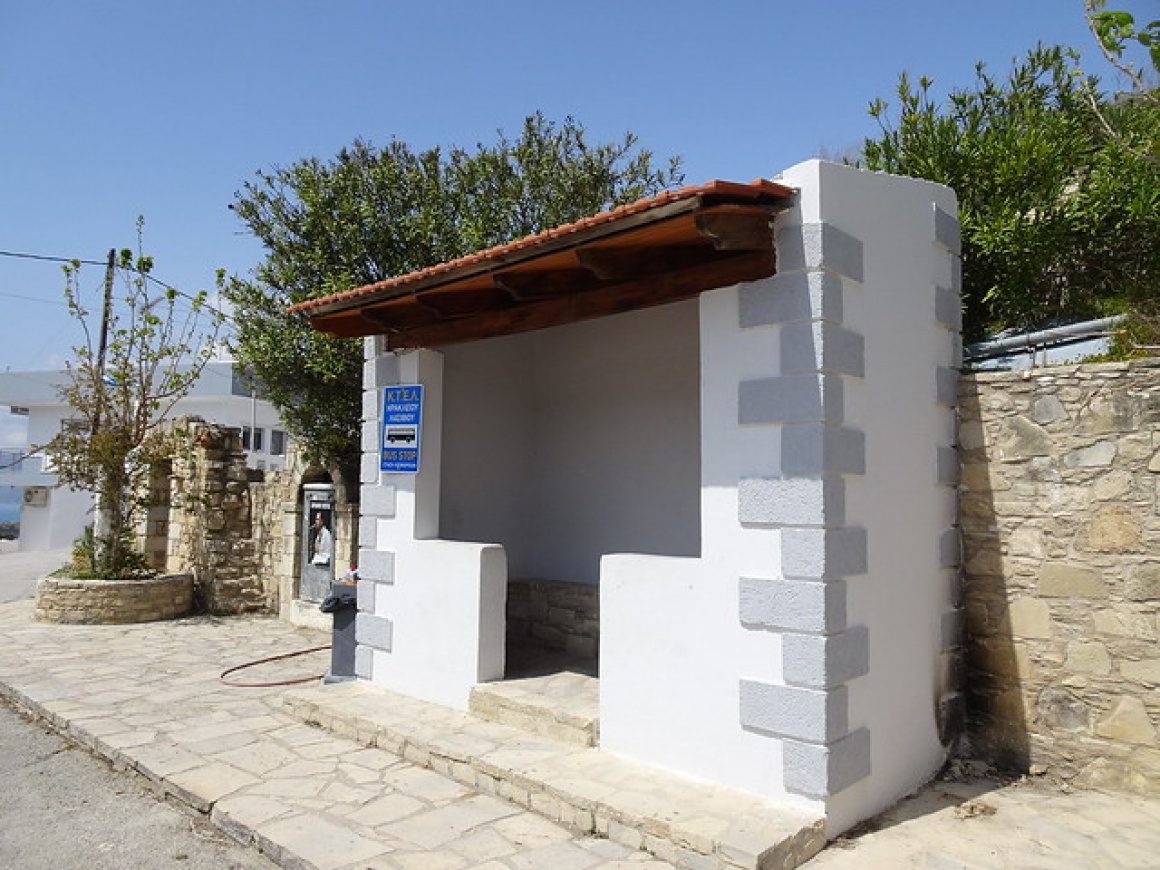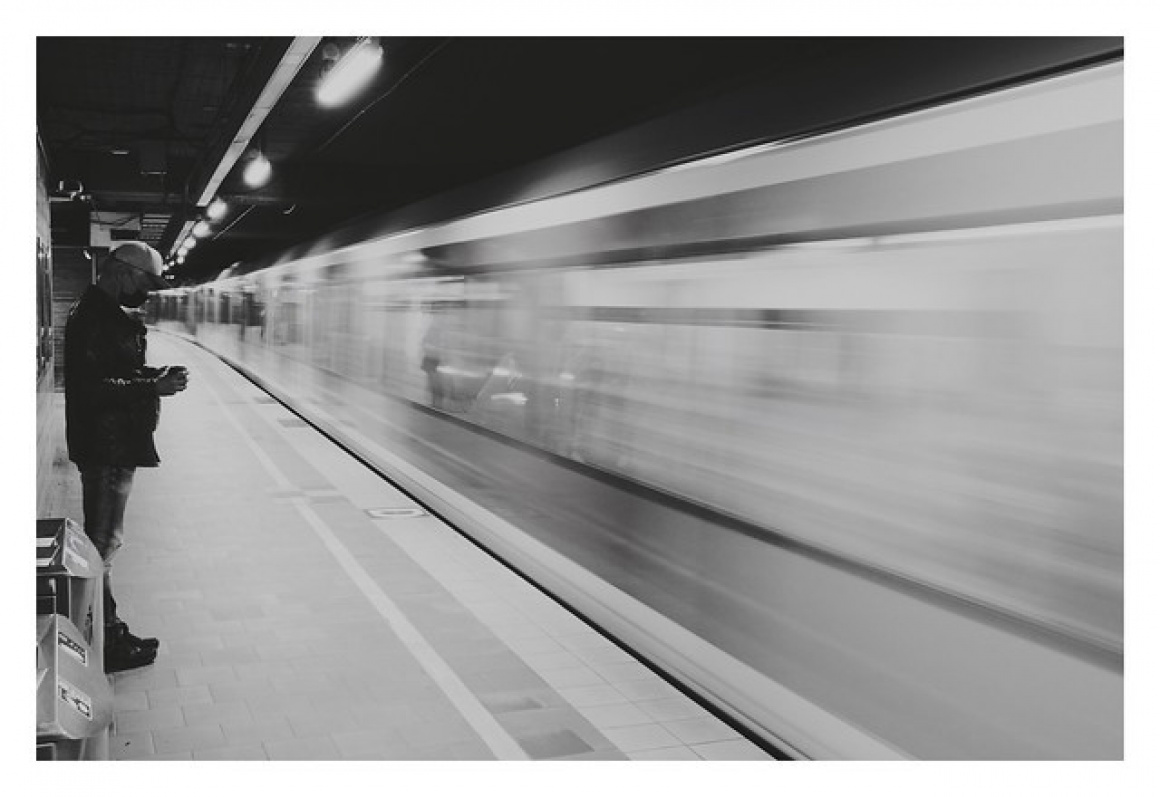For travellers exploring Crete without a car, public transportation – primarily the bus network – is your lifeline to getting around the island. While Crete is large, it's quite feasible to visit major cities, towns, and many villages or beaches using its public buses, which are generally reliable and affordable. In this guide, we'll explain everything you need to know about getting around Crete by public transport, including bus schedules, costs, navigating the system, and tips for a smooth journey. We'll also touch on any other public transit (boats, etc., where relevant) and how to manage without a car.
Overview of Crete's Bus System
Crete's main form of public transit is the KTEL bus network. KTEL is a company structure in Greece that runs intercity buses. On Crete, there are two regional KTEL divisions:

 'Bus and Cafe' - Attribution: mikecogh
'Bus and Cafe' - Attribution: mikecogh- KTEL Heraklion-Lasithi – operates buses in the eastern half of Crete (Heraklion, Hersonissos, Agios Nikolaos, Sitia, Ierapetra, etc.).
- KTEL Chania-Rethymno – covers the western half (Chania, Souda, Rethymno, Plakias, Kastelli-Kissamos, Paleochora, Sfakia, etc.).
They coordinate at the border of their regions (e.g., Rethymno to Heraklion). Buses are the workhorse of transport for locals and tourists alike. They range from big coaches for main routes to smaller minibuses for short or rural routes. They are generally clean, with air-conditioning (which may or may not be super cold), and have luggage storage under or inside for bigger bags.
Bus Stations:
- Heraklion has two main stations: Station A (by the port, for Rethymno, Chania, Agios Nikolaos, long distance) and Station B (Chanioporta, for some local routes like to Knossos). Most tourists will use Station A by the harbour.
- Chania has the Central Bus Station on Kidonias St. in the city centre (covers all routes).
- Rethymno's bus station is near the city marina.
- Agios Nikolaos bus station is in town near the hospital.

 'Village Bus Stop' - Attribution: mikecogh
'Village Bus Stop' - Attribution: mikecoghTickets & Fares:
Tickets are quite cheap compared to Western Europe. For example, the fares on some routes are as follows:
- Heraklion to Chania (2.5 hrs): approximately €15 one-way
- Heraklion to Rethymno: approximately €8
- Chania to Rethymno: approximately €6
- Heraklion to Agios Nikolaos: approximately €7
- Chania to Kastelli: approximately €5
- Ierapetra to Sitia: approximately €7
You usually buy tickets on board for intercity routes (there's a conductor or driver who issues them) or at the station ticket desk before boarding (in major stations). Some smaller route drivers prefer cash on board. If boarding at a main station with a queue, you often get a seat number; otherwise, it's open seating. They accept cash only (Euro), so have small bills/coins ideally. Multi-ride tickets or passes are not common for tourists, since each route is point-to-point. Locals sometimes have student discounts etc.
Luggage:
When placing big luggage in the under compartment, you may be given a tag and charged a €1 fee in some cases (for example, Heraklion KTEL sometimes charges for large suitcases). Inside the coach, above the seats, there are overhead racks for smaller bags.
Major Routes (Timetables):
- Heraklion – Chania: Buses run roughly every hour from early morning (around 5:30am) until the evening (around 8:30pm). They stop at Rethymno midway, with a travel time of approximately 2h45m (express services might do it in 2h30m).
- Heraklion – Rethymno: The same buses that run to Chania serve this route, with some extra services exclusively for Rethymno that might be slightly shorter.
- Heraklion – Agios Nikolaos: Buses are frequent, approximately every 60–90 minutes during the day. Some buses continue on to Ierapetra or Sitia.
- Heraklion – Hersonissos/Malia: Very frequent services (essentially a local bus line operated by KTEL) run roughly every 30 minutes during most of the day. Many buses continue onward to Agios Nikolaos.
- Heraklion – Airport: This is actually a city bus service rather than a KTEL service.
- Chania – Kissamos (Kastelli): Buses run about every 1–2 hours, with an increased frequency in summer. (Kissamos)
- Chania – Souda (ferry port): A city bus runs every 20 minutes, and many buses from Rethymno/Heraklion passing through Chania also stop at Souda.
- Chania – Sfakia (Hora Sfakion): Approximately 4 buses per day in summer (early morning, midday, and afternoon).
- Chania – Omalos (Samaria Gorge): Only available in the early morning (for hikers), usually one bus around 7:45am, maybe an earlier one for organised tour groups. The return from Samaria (via Sougia/Sfakia) is in the evening.
- Chania – Paleochora: Roughly 3–5 buses per day, depending on the season. (Paleochora)
- Rethymno – Plakias: Approximately 4–5 buses per day in summer.
- Heraklion – Knossos: City bus #2 or the dedicated Knossos bus from Station B runs every 15–20 minutes.
- Heraklion – Matala: About 3 buses per day, typically in the morning, midday, and afternoon (with fewer services in the off-season).
- Heraklion – Ierapetra: Approximately 5 buses per day; some services are direct while others require a change at Agios Nikolaos.
- Ierapetra – Sitia: A couple of buses per day along the south/east coast.
- Agios Nikolaos – Sitia: Around 4 buses per day.
- Heraklion – Anogia (Psiloritis foothills): A few services a day (mostly for locals).
- Heraklion – Marmaketo (Lassithi Plateau): 1 or 2 buses per day.
Essentially, major cities are well-connected with multiple daily buses. Touristic villages and beaches often have at least a morning and an afternoon connection from the nearest city. For instance, you could plan a day trip by bus: from Heraklion to Matala, catch an 8am bus arriving at 10am, then return on a 4pm bus to be back by 6pm, or from Chania to Elafonisi Beach (although the direct service is limited).
Tips for Riding the Bus:
- Arrive a bit early, especially if you need to purchase a ticket at the station. Popular routes (like a mid-day service to Chania in August) can fill up quickly; while extra buses might be added if one fills, it's better to be early than to stand.
- Retrieve your checked luggage promptly when you get off, and show your receipt tag if asked (rarely needed, but it helps ensure no one else claims it).
- At rural stops, you might have to flag the bus down even when at a marked stop, to ensure the driver sees you. Similarly, press the stop button or alert the driver when your stop is approaching.
- Bus stops in villages can be as simple as a sign or kiosk. Locals know them well, so don't hesitate to ask if you're unsure (for example, “Pou einai i stasi tou leoforeiou? – Where is the bus stop?”).
- On popular routes (such as the Heraklion–Chania service), seat assignments may be given; otherwise, seating is open, so couples should board promptly to secure seats together on busy runs.
- Air-conditioning can sometimes be too cold; carry a light jacket for long rides. Conversely, on very hot days the air-conditioning might not be strong enough and the bus might become stuffy – try to sit near an openable window or towards the front, where the A/C is more effective.
- Most buses do not have toilets (except perhaps on really long overnight routes on ferry connections), so use the facilities at the station before departure. On very long trips, there might be a rest stop – for example, the Heraklion to Sitia route sometimes stops at a roadside café halfway.
- Drivers may take a short smoke break at termini or major stops; it's not uncommon to see a bus driver having a coffee and a cigarette while passengers board or alight.
- Personal safety: Crete's buses are generally safe. However, always keep an eye on your valuables, as an unattended bag might attract unwanted attention.
- Another perk: It's a scenic way to travel. For instance, the Heraklion–Rethymno–Chania bus route runs along the coast, offering breathtaking sea views on one side and mountains on the other (for the best sea view, sit on the right side when heading west, or on the left when heading east).
Bus schedules vary by season. In summer (June–September), frequencies are higher; in winter services are reduced, especially to tourist spots. Always check updated times on the KTEL websites or at the station.
Connecting Between Systems:
If you travel from a destination in the Chania region to one in the Heraklion region (for example, from Chania to Agios Nikolaos), you will likely need to change buses at Rethymno or Heraklion. The KTEL systems coordinate to some extent – for instance, the Chania bus may continue on to Heraklion with Rethymno passengers onboard. However, if you need to travel further, you might have to alight in Heraklion and transfer to an eastbound bus. Often, the KTEL ticket offices will sell you a ticket to your final destination that includes a transfer, though on occasion you may have to purchase separate tickets for each leg of your journey.
Public Boats:
Aside from buses, another form of public transport in some areas is the ferry or boat. Along the south coast, for example, there is a ferry that connects coastal villages not reachable by road (such as Loutro, Agia Roumeli, etc.). This service runs daily in summer and essentially functions like a bus for hikers and locals. In some cases a small boat runs from Plakias to Preveli Beach during the tourist season.
To reach certain secluded beaches or islands – for instance, Elafonisi Beach from Paleochora, Chrissi Island from Ierapetra, or Gramvousa from Kissamos – excursion boats are available. Although not strictly public transport, these day ferries are widely used. If you wish to travel from Crete to other islands by ferry (such as Santorini or Karpathos), these services are provided by major ferry companies and are akin to intercity train or plane travel.
Using Public Transport Without a Car:
If you base yourself in, say, Chania, you can reach many sites by bus – such as a day trip to Rethymno or a visit to Samaria (take the bus to Omalos, then the ferry back and another bus to Chania). From Heraklion, buses connect you to Knossos, to Rethymno or Chania, and even to Malia/Hersonissos for beaches, as well as to Agios Nikolaos.
To reach some off-the-beaten-track places, you might have to combine modes – for example, take a bus to the nearest town and then a taxi to your final destination. For instance, to visit the Lassithi Plateau, there is a bus from Heraklion to Tzermiado, though it runs rarely; an alternative is to take a bus from Heraklion to Malia and then a taxi up to Lassithi. Similarly, to get to Balos Beach, no public bus goes directly there because the last leg requires either a ferry or a rough road, so many travellers take a bus to Kissamos port and then a boat to Balos. In high season, special arrangements such as a combined bus and boat ticket may be available.
If you are completely without a car and want to explore more remote areas – such as villages or certain gorges not served by the main bus routes – consider joining an organised day tour.
Cost-Benefit:
Public transport is extremely economical: for example, a roundtrip from Chania to Elafonisi Beach via public bus may cost around €25, compared to a rental car at approximately €40 per day plus fuel costs and the hassle of navigating mountain roads. For two or more people, sometimes splitting the cost of a rental or taxi offers greater flexibility.
Many travellers choose a balanced approach: use buses for intercity travel (eliminating parking worries), then rent a car locally for one or two days to visit harder-to-reach areas, or use buses between town bases and rent a scooter or car for a day trip in the local area.
Sunday/Holiday Service:
Buses run on weekends and holidays, though with reduced frequency on smaller routes in the off-season. In high season, Sundays often operate nearly as normal on main lines due to tourist demand, but routes mainly used by local commuters or on market days might not run. Be especially mindful if travelling on major holidays such as Orthodox Easter, when many services may be suspended.
Local City Buses:
In Heraklion, aside from KTEL, there is an urban blue bus network serving the city centre and nearby suburbs (including connections to Knossos, the Airport, and Amoudara beach). In Chania, city buses travel to locations such as the airport, Souda, and nearby beaches (for example, Agii Apostoli and Kalamaki on the outskirts). Rethymno's local buses can, for instance, take you to landmarks like Arkadi Monastery (though some of these services are part of the KTEL regional network).
Accessibility:
Buses are generally standard coaches with low entry, but not all are wheelchair accessible; some newer models are equipped with lifts or lowerable steps. If you have mobility issues, you might consider private transfers or inquire whether KTEL can provide an accessible bus on your chosen route. Strollers can typically be stored underneath or in designated spaces if the bus isn't full.
In Short:
- Coverage: Buses reach most places a traveller would want to go, provided some planning is undertaken.
- Frequency: Services are good on main routes, moderate on secondary ones, and sparse in remote areas – so it's wise to familiarise yourself with the timetables (many hotels and stations offer printed schedules).
- Cost: Public transport is very affordable. You can cross the entire island (for example, from Chania to Sitia in about 6 hours via transfers) for roughly €25 in total.
Without a car, it is absolutely possible to see Crete's highlights. Perhaps the only places you might miss are those truly off the main roads (some hidden beaches or mountain villages not served by bus routes), but these can often be reached via a guided tour or a short taxi ride. One might even combine modes of transport: use buses where convenient and call a taxi when it saves time. For example, if you finish a Samaria hike and are exhausted, you could take a taxi from Sfakia to Chania (though this may be expensive, around €100) or opt for an organised tour bus.
Anecdote: I once used the bus to travel from Heraklion to a mountain town called Spili – I had to change buses in Rethymno before catching the final leg. The connection was tight, but the second bus waited a few minutes after communicating with the first, ensuring I reached Spili for just a few euros while enjoying scenic routes. So trust the system – it has been serving islanders for decades.
All in all, with a bit of patience and an eye on the timetable, public transport will get you around Crete efficiently. Sit back and enjoy the ride – let someone else do the driving while you gaze at the olive groves and the sea.


